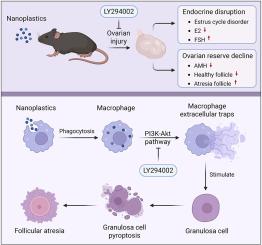聚苯乙烯纳米塑料通过PI3K-Akt通路驱动巨噬细胞胞外陷阱形成诱导卵巢损伤
IF 7.3
2区 环境科学与生态学
Q1 ENVIRONMENTAL SCIENCES
引用次数: 0
摘要
纳米塑料(NPs)是一种新兴且日益普遍的环境污染物,对生物构成了重大威胁。虽然最近的研究已经开始阐明NPs诱导卵巢毒性的机制,但细胞相互作用,特别是涉及免疫细胞的相互作用,在卵巢损伤中的作用仍然知之甚少。在这里,我们建立了一个暴露于聚苯乙烯纳米塑料超过8周的小鼠模型,以探索巨噬细胞在nps诱导的卵巢损伤中的作用。我们的体内实验结果表明,NPs在卵巢组织中积累,导致卵巢内分泌紊乱和卵泡闭锁,并伴有巨噬细胞浸润和巨噬细胞胞外陷阱(METs)的形成。利用巨噬细胞和颗粒细胞(GCs)共培养系统进行的补充研究表明,NPs诱导的METs触发了GCs的焦亡,这种生物串扰可以通过DNase i减轻。进一步的转录组学分析显示,NPs通过激活PI3K-Akt信号通路促使巨噬细胞释放METs。值得注意的是,PI3K-Akt通路的特异性抑制剂LY294002可显著抑制METs的形成,从而挽救NPs诱导的GCs焦亡和卵巢损伤。综上所述,我们的研究结果揭示了METs在加剧NPs诱导的卵巢损伤中的机制作用,并强调了PI3K-Akt信号通路作为潜在的治疗靶点。本文章由计算机程序翻译,如有差异,请以英文原文为准。


Polystyrene nanoplastics induce ovarian injury by PI3K-Akt pathway-driven macrophage extracellular trap formation
Nanoplastics (NPs), an emerging and increasingly prevalent environmental pollutant, pose a significant threat to organisms. Although recent research has begun to elucidate the mechanisms underlying ovarian toxicity induced by NPs, the involvement of cellular interactions, particularly those involving immune cells, in ovarian injury remains poorly understood. Here, we established a murine model exposed to polystyrene nanoplastics over an 8-week period to explore the role of macrophages in NPs-induced ovarian injury. Our in vivo results demonstrated that NPs accumulated in ovarian tissues, leading to ovarian endocrine disruption and follicular atresia, concomitant with macrophages infiltration and the formation of macrophage extracellular traps (METs). Complementary investigation using a co-culture system of macrophages and granulosa cells (GCs) indicated that NPs-induced METs triggered pyroptosis of GCs, and this biological crosstalk could be mitigated by DNase I. Further transcriptomic analysis revealed that NPs prompted macrophages to release METs through activating the PI3K-Akt signaling pathway. Notably, LY294002, a specific inhibitor of the PI3K-Akt pathway, significantly suppressed METs formation and consequently rescued GCs pyroptosis and ovarian injury induced by NPs. In summary, our findings uncover the mechanistic role of METs in exacerbating ovarian injury induced by NPs, and highlight the PI3K-Akt signaling pathway as a potential therapeutic target.
求助全文
通过发布文献求助,成功后即可免费获取论文全文。
去求助
来源期刊

Environmental Pollution
环境科学-环境科学
CiteScore
16.00
自引率
6.70%
发文量
2082
审稿时长
2.9 months
期刊介绍:
Environmental Pollution is an international peer-reviewed journal that publishes high-quality research papers and review articles covering all aspects of environmental pollution and its impacts on ecosystems and human health.
Subject areas include, but are not limited to:
• Sources and occurrences of pollutants that are clearly defined and measured in environmental compartments, food and food-related items, and human bodies;
• Interlinks between contaminant exposure and biological, ecological, and human health effects, including those of climate change;
• Contaminants of emerging concerns (including but not limited to antibiotic resistant microorganisms or genes, microplastics/nanoplastics, electronic wastes, light, and noise) and/or their biological, ecological, or human health effects;
• Laboratory and field studies on the remediation/mitigation of environmental pollution via new techniques and with clear links to biological, ecological, or human health effects;
• Modeling of pollution processes, patterns, or trends that is of clear environmental and/or human health interest;
• New techniques that measure and examine environmental occurrences, transport, behavior, and effects of pollutants within the environment or the laboratory, provided that they can be clearly used to address problems within regional or global environmental compartments.
 求助内容:
求助内容: 应助结果提醒方式:
应助结果提醒方式:


